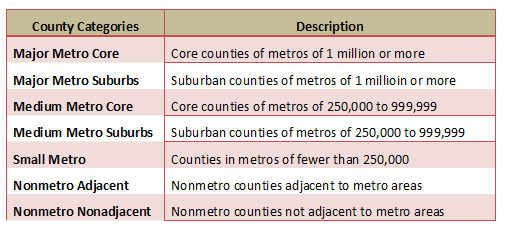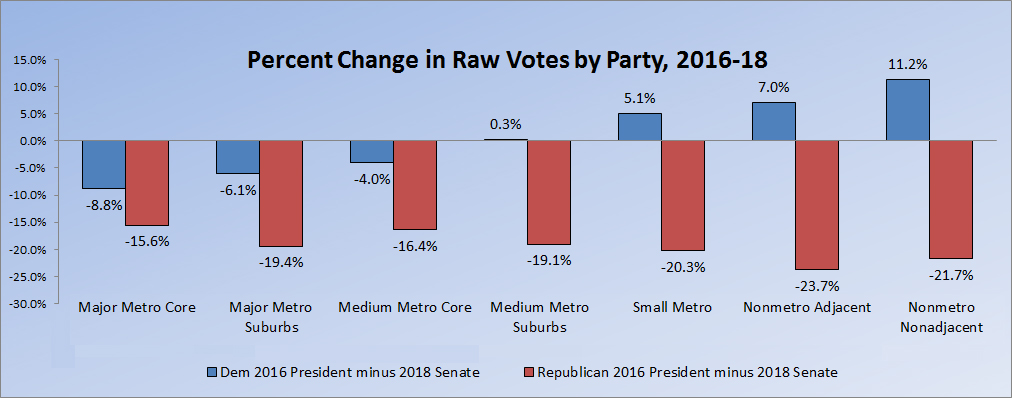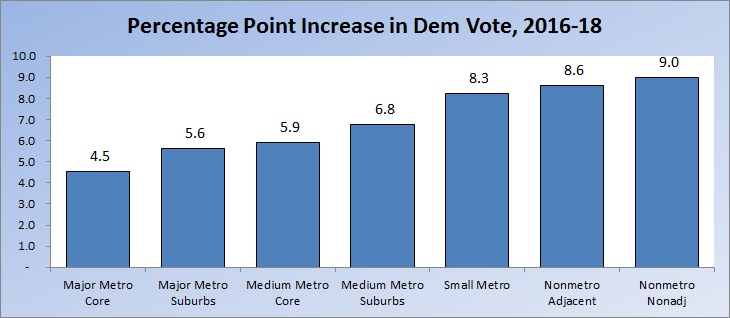Democratic Senate candidates cut the party’s rural deficit compared to the presidential vote in 2016. But Republicans still outperformed Democrats by 22 points in 28 states we studied.
Republicans gained seats in the U.S. Senate in the last election, but it’s Democrats who gained in popularity among rural voters.
 The Daily Yonder looked at the currently available Senate vote and compared those figures to the presidential election of 2016. When we grouped counties by metropolitan categories, we found that Democrats improved their performance across the board from 2016 and that the biggest gains came in the more rural counties.
The Daily Yonder looked at the currently available Senate vote and compared those figures to the presidential election of 2016. When we grouped counties by metropolitan categories, we found that Democrats improved their performance across the board from 2016 and that the biggest gains came in the more rural counties.
Comparing presidential elections to midterm elections is a bit of an apples-to-oranges exercise. But that doesn’t keep analysts from digging in. So, in the interest of keeping rural in the conversation, let’s take a look at rural voter preferences this year compared to 2016.
Note: The Senate election data we are using is from Dave Leip’s election atlas. We omitted California because there was no Republican on the ballot. That left 28 races for which data was available. There’s a list at the bottom of the article. We counted the votes for Vermont’s Bernie Sanders, who is an independent, in the Democratic column.
First, let’s look at the raw vote.

Midterm elections always attract fewer voters than presidential elections. So we expect the raw vote total to decline. But in rural counties, the raw number of voters who selected the Democratic candidate actually increased from 2016 to 2018. Democratic Senate candidates in the most rural counties got 11% more votes this year than Hillary Clinton did in 2016. That’s despite the fact that 12 million fewer people voted in those states overall.
Meanwhile, the raw number of votes for Republican Senate candidates declined from Donald Trump’s raw vote total in 2016 in every category of county – from the smallest rural areas to the largest metropolitan ones. The declines were more pronounced in small metropolitan areas (metros with fewer than 250,000 residents) and rural counties.
The Democratic gains are also striking when we look at the proportion (or percentage) of the two-party vote the candidates received.

Democratic Senate candidates in 2018 did better than Clinton in the two-party percentage vote in every category of county (from urban centers to rural areas). Again, the Democratic gains were biggest in rural counties. Democrats improved their performance by 9 percentage points in the most rural counties. (As a percentage basis [vs. a percentage point basis], that’s a whopping 30% increase.)
The vote in these Senate races is an interesting midterm snapshot of rural voter opinion. It’s not determinative for 2020, however. Even though Democrats substantially improved their performance with rural voters in these states this year, they still lost the popular vote in rural counties. Democrats trimmed the Republican margin of victory in the states we examined from 40 points to 22. If the patterns we’ve seen in elections in this century hold, Democrats will have to do better than that to win the White House in 2020.
States included in this analysis are the following: Arizona, Connecticut, Delaware, Florida, Hawaii, Indiana, Maryland, Michigan, Minnesota, Missouri, Montana, Nebraska, Nevada, New Jersey, New Mexico, New York, North Dakota, Ohio, Pennsylvania, Rhode Island, Tennessee, Texas, Utah, Vermont, Virginia, Washington, West Virginia and Wyoming.
This story was originally published by the Daily Yonder.



